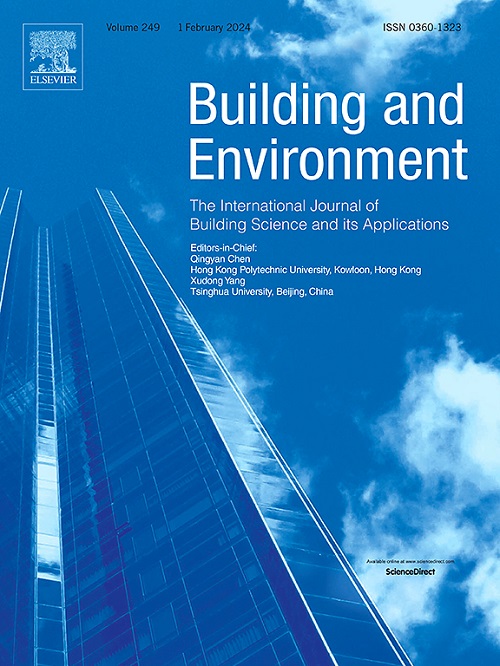高代谢环境中的呼吸道疾病传播:健身房案例研究
IF 7.1
1区 工程技术
Q1 CONSTRUCTION & BUILDING TECHNOLOGY
引用次数: 0
摘要
据报道,健身中心经常爆发呼吸道传染病,这可能归因于人口密度大、共用表面多以及代谢当量(MET)水平升高。本研究分析了 30 名健身中心参与者的行为,以建立运动强度与病毒暴露之间的联系。研究人员使用自主研发的可穿戴设备,利用计算机视觉技术跟踪参与者之间的亲密互动,同时使用摄像机记录表面接触行为。随后,结合观察到的行为,建立了呼吸道传染病的多途径传播模型。以 COVID-19 的 Omicron 变种为案例,评估通过各种传播途径的感染风险,并评估干预措施的效果。体力活动时的 METs 比休息时记录的 METs 高出约 3.5 倍。据测量,在健身房进行亲密互动时的平均人际距离为 0.82 米,其中 36.7% 的互动是面对面进行的。参与者平均每小时接触物体表面 770.3 次,其中 517.5 次涉及公共物体表面。经计算,每小时的感染率为 18.5%,其中远距离空气传播和近距离接触分别占 70.1% 和 28.5%。为降低传播风险,模拟了几种干预方案。这些方案包括:(1)100% 戴 N95 口罩,占用率降至 62%(25 平方米/人);(2)100% 戴外科口罩,占用率降至 26%(59.6 平方米/人);(3)不戴口罩,占用率降至 18%(86.1 平方米/人)。所有方案都符合 Rt 低于 1 的标准,表明在这些条件下,健身房可以安全地重新开放。本文章由计算机程序翻译,如有差异,请以英文原文为准。
Transmission of respiratory diseases in high-metabolic environments: A case study of gym
Outbreaks of respiratory infectious diseases have often been reported in fitness centers, likely attributed to high population density, extensive shared surfaces, and elevated metabolic equivalent (MET) levels. This study analyzed the behaviors of 30 gym attendees to establish a connection between exercise intensity and virus exposure. Close interactions among participants were tracked using self-developed wearable devices that utilized computer vision technologies, while surface-contact behaviors were recorded using video cameras. A multi-route transmission model for respiratory infectious diseases was subsequently created, integrating the observed behaviors. The Omicron variant of COVID-19 served as a case study to evaluate infection risk via various transmission routes and to assess the efficacy of interventions. The METs during physical activity were about 3.5 times higher than those recorded at rest. The average interpersonal distance during close interactions in the gym was measured at 0.82 m, with 36.7 % of interactions occurring face-to-face. On average, the participants made contact with surfaces 770.3 times per hour, with 517.5 of these contacts involving public surfaces. The hourly infection rate was calculated at 18.5 %, with long-range airborne transmission and close contact accounting for 70.1 % and 28.5 % of the cases, respectively. To mitigate transmission risk, several intervention scenarios were modeled. These included (1) 100 % mask-wearing with N95 masks and occupancy reduced to 62 % (25 /person); (2) 100 % mask-wearing with surgical masks and occupancy reduced to 26 % (59.6 /person); (3) no mask-wearing, with occupancy reduced to 18 % (86.1 /person). All scenarios fulfilled the criteria for achieving an below 1, indicating that under these conditions, gyms could be reopened safely.
求助全文
通过发布文献求助,成功后即可免费获取论文全文。
去求助
来源期刊

Building and Environment
工程技术-工程:环境
CiteScore
12.50
自引率
23.00%
发文量
1130
审稿时长
27 days
期刊介绍:
Building and Environment, an international journal, is dedicated to publishing original research papers, comprehensive review articles, editorials, and short communications in the fields of building science, urban physics, and human interaction with the indoor and outdoor built environment. The journal emphasizes innovative technologies and knowledge verified through measurement and analysis. It covers environmental performance across various spatial scales, from cities and communities to buildings and systems, fostering collaborative, multi-disciplinary research with broader significance.
 求助内容:
求助内容: 应助结果提醒方式:
应助结果提醒方式:


